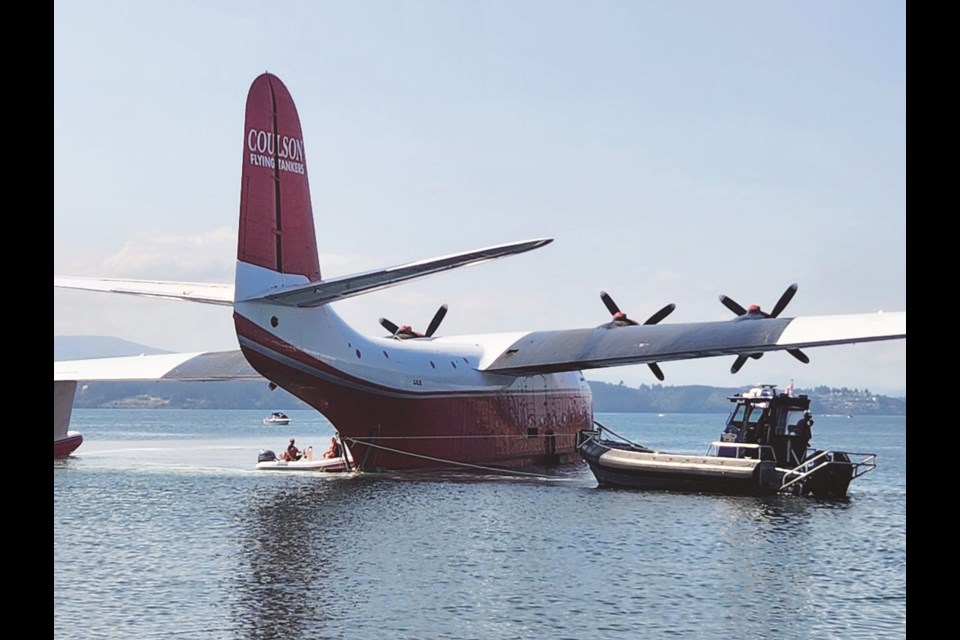Moving the Hawaii Martin Mars water bomber out of the water at Patricia Bay and on to dry land was like threading a needle.
The massive plane had to be twisted and turned between two breakwaters at the Canadian Coast Guard facility using a series of ropes and cables that involved several boats and about 20 workers all in constant radio communication.
The 5 1/2-hour operation on Thursday was led by Coldwater Divers and Nickel Brothers Movers with assistance from contractors and volunteers.
“It was like big airplane yoga, but very slow and an inch at a time,” said Richard Mosdell, who headed the project to bring the Martin Mars to the B.C. Aviation Museum where it will be put on display as an exhibit.
The 120-foot-long Hawaii Martin Mars, which has a 200-foot wingspan, couldn’t be hauled straight out at the boat ramp.The wings are too long, the pontoons on the wings too low to clear the breakwaters.
“It was a lot of work and very challenging,” said Adam Coolidge, chief executive of Coldwater Divers and a 17-year veteran of the Royal Canadian Navy. “But it was very satisfying to get it done.”
Coolidge installed 12 connections on the big airplane to attach cables and heavy ropes so a towing vessel could turn the airplane through the breakwaters.
Through a series of pulls from different connection points, Coolidge and Nickel Brothers Movers were able to “walk it through sideways” using constant communication from crews on two sides.
There was never more than just a few feet of clearance, he said, “so it was very slow work.”
The plane’s nose was anchored to the breakwaters at three points at any give time during the move to ensure turns were made gradually and slowly. Movable airbag bumpers were installed at some areas to prevent any potential rough contact,and guiding boats were used to push and align the Martin Mars as it cleared the breakwaters, Coolidge said.
Mosdell said the Martin Mars does not have a keel and is meant to move straight ahead, so all the sideways moves were done at a snail’s pace.
At one point, some steel lampposts on the breakwaters had to be removed so the wings and pontoons could clear them.
Slight changes in wind speeds also required adjustments to the lines to keep the plane from drifting or moving from its route, Coolidge said.
Mosdell said the moves were “literally inches at a time … Bow, then stern. Bow, then stern. I held a line for two hours and just did what I was told.”
He said he’s never seen such skill and professionalism as he did watching Coolidge and Nickel Brothers principals Jeremy Nickel and Tim Nickel.
“These guys are the very best at what they do,” Mosdell said. “They plan in inches.”
The Hawaii Martin Mars was eventually brought up to the ramp and winched out of the water by the tail end, with not a scratch on it.
The timing of the operation was critical because of the narrow high-tide window in Patricia Bay and because prolonged exposure to salt water wouldn’t be good for the plane’s fuselage.
The plane was being rinsed on the shore on Thursday.
The Hawaii Martin Mars landed in Patricia Bay on Sunday evening after a historic last flight from Sproat Lake that was witnessed by tens of thousands of people along the east side of the Island and Greater Victoria.
The plane is headed to the B.C. Aviation Museum as a new exhibit.
Contractor Villamar Construction was also at the site to widen the boat ramp and assist with clearing other obstacles.
Beaching gear wheels to allow it to manoeuvre onto land were attached to the aircraft.
At 18 feet, three inches wide, the gear left only six inches to spare on the ramp.
Villamar Construction was given permission to remove several concrete block walls to widen the ramp by 18 inches.
“Normally that would have taken days, but Villamar did it five hours,” said Mosdell.
In a social media post, managing partner Michael Edwardson said when the company got the call from the B.C. Aviation Museum, it was a “drop everything and make it happen moment.”
“Our collaboration with Nickel Brothers, who led the charge with expertise, was seamless,” he said, adding: “Those guys know how to make things happen.”
B.C. Aviation Museum President Steve Nichol said the process “was incredible to watch, just amazing how good these guys are. They did what a lot of people thought was impossible.”
After the de-watering process, Nickel Brothers will lift the plane onto a 360-degree movable heavy-haul trailer and tow the water bomber from the bay.
The journey to the aviation museum will happen next week, with Nickel Brothers moving the plane across West SaanichRoad and over airport lands during the night to minimize disruption at Victoria International Airport.
Mosdell said the move will take place Between Monday and Friday. The exact date isn’t being announced publicly because security fences are being taken down at the both the Institute for Ocean Sciences where the coast guard ramp is located and the airport lands.
The museum is hosting its open house this Saturday and Sunday from 10 a.m. to 4 p.m. with admission by donation.
There will be exhibitors, visiting aircraft and helicopters, skydivers as well as food trucks.
Although the Hawaii Martin Mars won’t be on the site, there will be a range of original Mars merchandise on sale, a major fundraising effort for the museum to help finance a new hangar for the Martin Mars.
More than 40 other aircraft will be available for the public to view.


